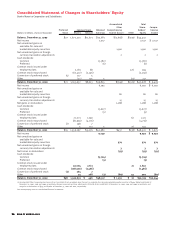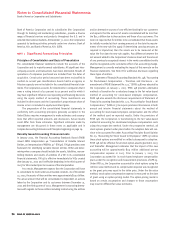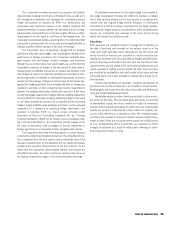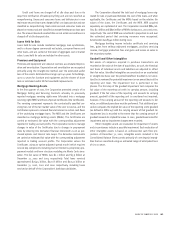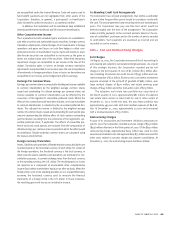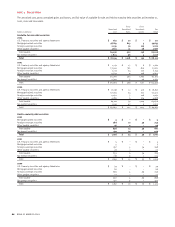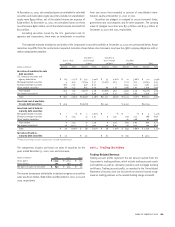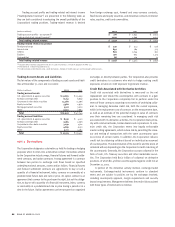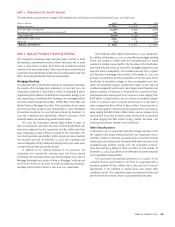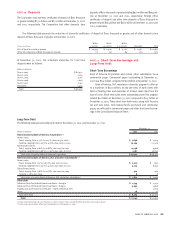Bank of America 2002 Annual Report Download - page 85
Download and view the complete annual report
Please find page 85 of the 2002 Bank of America annual report below. You can navigate through the pages in the report by either clicking on the pages listed below, or by using the keyword search tool below to find specific information within the annual report.
BANK OF AMERICA 2002 83
are nonqualified under the Internal Revenue Code and assets used to
fund benefit payments are not segregated from other assets of the
Corporation; therefore, in general, a participant’s or beneficiary’s
claim to benefits under these plans is as a general creditor.
In addition, the Corporation and its subsidiaries have established
several postretirement healthcare and life insurance benefit plans.
Other Comprehensive Income
The Corporation records unrealized gains and losses on available-for-
sale debt securities and marketable equity securities, foreign currency
translation adjustments, related hedges of net investments in foreign
operations and gains and losses on cash flow hedges in other com-
prehensive income in shareholders’ equity. Gains and losses on avail-
able-for-sale securities are reclassified to net income as the gains or
losses are realized upon sale of the securities. Other-than-temporary
impairment charges are reclassified to net income at the time of the
charge. Translation gains or losses on foreign currency translation
adjustments are reclassified to net income upon the sale or liquidation
of investments in foreign operations. Gains or losses on derivatives are
reclassified to net income as the hedged item affects earnings.
Earnings Per Common Share
Earnings per common share is computed by dividing net income available
to common shareholders by the weighted average common shares
issued and outstanding. For diluted earnings per common share, net
income available to common shareholders can be affected by the
conversion of the registrant’s convertible preferred stock. Where the
effect of this conversion would have been dilutive, net income available
to common shareholders is adjusted by the associated preferred divi-
dends. This adjusted net income is divided by the weighted average
number of common shares issued and outstanding for each period plus
amounts representing the dilutive effect of stock options outstanding
and the dilution resulting from the conversion of the registrant’s con-
vertible preferred stock, if applicable. The effects of convertible pre-
ferred stock and stock options are excluded from the computation of
diluted earnings per common share in periods in which the effect would
be antidilutive. Dilutive potential common shares are calculated using
the treasury stock method.
Foreign Currency Translation
Assets, liabilities and operations of foreign branches and subsidiaries are
recorded based on the functional currency of each entity. For certain of
the foreign operations, the functional currency is the local currency, in
which case the assets, liabilities and operations are translated, for con-
solidation purposes, at current exchange rates from the local currency
to the reporting currency, the U.S. dollar. The resulting gains or losses
are reported as a component of accumulated other comprehensive
income (loss) within shareholders’equity on an after-tax basis. When the
foreign entity is not a free-standing operation or is in a hyperinflationary
economy, the functional currency used to measure the financial
statements of a foreign entity is the U.S. dollar. In these instances,
the resulting gains and losses are included in income.
Co-Branding Credit Card Arrangements
The Corporation has co-brand arrangements that entitle a cardholder
to earn airline frequent-flyer points based on purchases made with
the card. These arrangements have remaining terms not exceeding six
years. The Corporation may pay one-time fees which would be
deferred ratably over the term of the arrangement. The Corporation
makes monthly payments to the co-brand partners based on the vol-
ume of cardholders’ purchases and on the number of points awarded
to cardholders. Such payments are expensed as incurred and are
recorded as contra-revenue.
NOTE 2 Exit and Restructuring Charges
Exit Charges
On August 15, 2001, the Corporation announced that it was exiting its
auto leasing and subprime real estate lending businesses. As a result
of this strategic decision, the Corporation recorded pre-tax exit
charges in the third quarter of 2001 of $1.7 billion ($1.3 billion after-
tax) consisting of provision for credit losses of $395 million and non-
interest expense of $1.3 billion. Business exit costs within noninterest
expense consisted of the write-off of goodwill of $685 million, auto
lease residual charges of $400 million, real estate servicing asset
charges of $145 million and other transaction costs of $75 million.
The subprime real estate loan portfolio was securitized in
the fourth quarter of 2001. Approximately $82 million of subprime
real estate loans remain in loans held for sale in other assets at
December 31, 2002. At the exit date, the auto lease portfolio was
approximately 495,000 units with total residual exposure of $6.8 bil-
lion. At December 31, 2002, approximately 227,000 units remained
with a residual exposure of $3.0 billion.
Restructuring Charges
As part of its productivity and investment initiatives announced on
July 28, 2000, the Corporation recorded a pre-tax charge of $550 million
($346 million after-tax) in the third quarter of 2000. Of the $550 million
restructuring charge, approximately $475 million was used to cover
severance and related costs and approximately $75 million was used for
other costs related to process change and channel consolidation. At
December 31, 2002, the restructuring reserve had been utilized.



